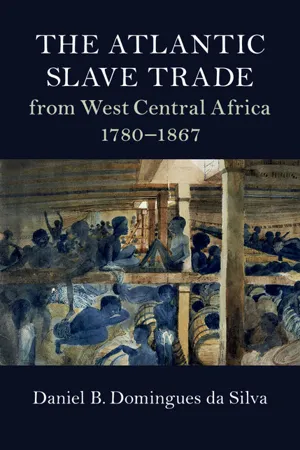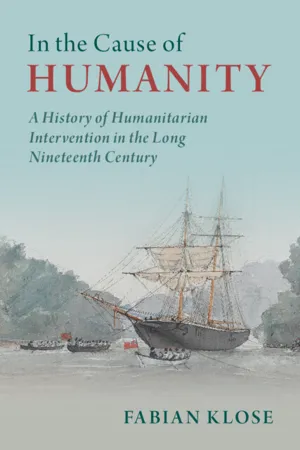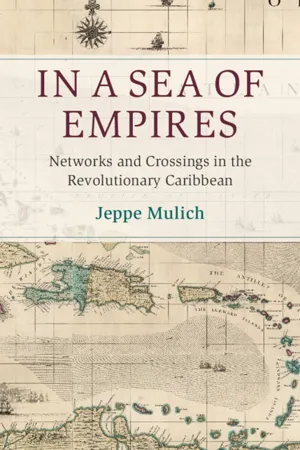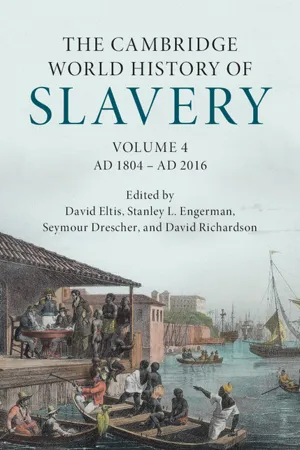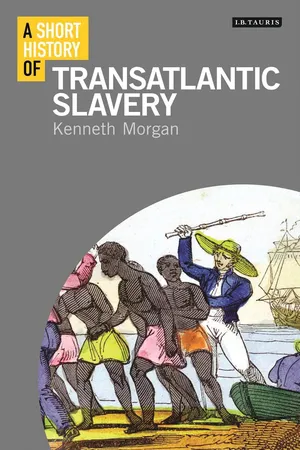History
Abolition of Slave Trade
The abolition of the slave trade refers to the movement to end the transportation of enslaved people across the Atlantic Ocean. This movement gained momentum in the late 18th and early 19th centuries, leading to the passage of laws that prohibited the trading of slaves. The abolition of the slave trade was a significant step towards the eventual eradication of slavery in many countries.
Written by Perlego with AI-assistance
Related key terms
1 of 5
10 Key excerpts on "Abolition of Slave Trade"
- Daniel B. Domingues da Silva(Author)
- 2017(Publication Date)
- Cambridge University Press(Publisher)
1 The Atlantic Slave Trade in the Century of Abolition In the late eighteenth century, the slave trade from West Central Africa entered a new age of social, political, economic, and ultimately ideological change. Economic growth and industrialization in Europe, particularly in Britain, increased the demand for primary commodities imported from the Americas, such as sugar, cotton, rice, and tobacco. These were pro- duced with slave labor brought from Africa and, as the demand for these items increased, so did the demand for slaves carried across the Atlantic. Ironically, although slavery was widespread in the Americas, some Europeans had begun to question the morality of an institution that deprived some individuals of their liberty for the benefit of others. 1 Moreover, they became increasingly persuaded that slave labor was infer- ior to free labor because slaves lacked the incentive to work. 2 The French Revolution and the 1791 slave rebellion in Saint Domingue, present-day Haiti, further questioned slavery, contributing to the spread of the aboli- tionist movement in the Atlantic world. 3 As a consequence, at the begin- ning of the nineteenth century, the slave trade declined as some nations began to retreat from the business. In 1807, both the US Congress and the British Parliament prohibited their citizens from participating in the trade and, soon after, the British initiated a campaign to suppress the entire 1 Davis, Inhuman Bondage, 231–49. 2 Seymour Drescher, The Mighty Experiment: Free Labor versus Slavery in British Emancipation (New York: Oxford University Press, 2002), 9–23. The main source for this argument is Adam Smith, An Inquiry into the Nature and Causes of the Wealth of Nations (London: W. Strahan and T. Cadell, 1776), vol. 1, 471–72. 3 Davis, Inhuman Bondage, 160–61. 16 trade from Africa, which continued throughout the balance of the nine- teenth century.- eBook - PDF
- Howard J. Wiarda(Author)
- 1995(Publication Date)
- Yale University Press(Publisher)
271 Part VI Abolition and Suppression of the Transatlantic Slave Trade I n a very real sense, captives on board slave vessels attempted to suppress the slave trade by attempting to capture the vessels taking them away from Africa. European nations took action against the slave trade from 1792, when Den- mark outlawed its slave trade, a ban effective in 1803. Both Britain and the United States outlawed theirs in 1807, with their bans effective the next year, but in most countries abolition came about in two stages. The first was the struggle to pass for- mal laws against transatlantic slave trading, and the second was the fight to make the laws effective. Unlike the fight against slavery itself, which took place largely within the confines of the state, the campaign against the slave trade always had a strong international dimension. Many nations took action against the slave trade only after signing treaties agreeing to do so. The issue became inextricably inter- twined with the emergence of international law, the definition of piracy, and the thorny question of intervention by one sovereign state in the affairs of another in the face of what today would be called human rights abuses. The narrative of the formal abolition of the transatlantic slave trade is straightforward. Portugal was the last nation in the Atlantic world to abolish the slave trade—in 1836. But once all nations had agreed that it should end, it did, in just over three decades—even though long-distance slave trading had probably been acceptable since before the first written records were kept. Individual states in the United States prohibited the slave trade before the 1807 federal act. Those actions aside, we can say it took thirty-three years for all Atlantic nations to move to stop the traffic (from Denmark’s implementation in 1803 to Portugal’s ban in 1836). - eBook - PDF
In the Cause of Humanity
A History of Humanitarian Intervention in the Long Nineteenth Century
- Fabian Klose(Author)
- 2021(Publication Date)
- Cambridge University Press(Publisher)
The act dealt a decisive blow to the British slave trade, two-thirds of which involved foreign states and territories. 9 The abolitionist cause hoped to capitalise on this success by pushing for the final, decisive step, in which the remainder of the British slave trade would be eliminated. Already in June 1806 a resolution was sub- mitted to both Houses condemning the slave trade as ‘contrary to the principles of justice, humanity, and sound policy’ 10 and thereby restating the link between humanitarian considerations and those of realpolitik. Moreover, with a general election called later in the year, abolition came to be regarded as an important issue in a number of constituencies. The abolitionist members, who worked hard to win over their fellow parlia- mentarians, began to find the numbers shifting in their favour. A key part fell to the prime minister, Lord Grenville, who along with other members of his ‘Ministry of All the Talents’ brought his influence to bear on the House of Lords, which had hitherto frustrated many abolitionist projects, and changed many minds for good. 11 These efforts bore fruit when in the spring of 1807 first the House of Lords (by 100 votes to 34) and then the House of Commons (by an overwhelming 286 votes to 16) voted in favour of a bill outlawing any British involvement in the slave trade. On 25 March 1807, King George III signed his assent to the Act of the British Parliament for the Abolition of the Slave Trade. 12 The abolition- ist cause had triumphed. Following a humanitarian campaign that had Slave Trade Act & Beginning of Military Intervention 73 been passionately fought for twenty years, a cause which had emerged in the realm of civil society had been adopted as government policy – as the policy of the United Kingdom, no less, which hitherto had been the leading nation in the slave trade. A humanitarian policy thereby became a key paradigm in the foreign policy of the nineteenth century’s most powerful nation. - Derek R. Peterson(Author)
- 2010(Publication Date)
- Ohio University Press(Publisher)
101 f o u r Ending the Slave Trade A Caribbean and Atlantic Context P H I L I P D . M O R G A N t h e A B o l I t I o n of the slave trade was an improbable event. Before the late eighteenth century some Europeans felt unease about the thought of shipping enslaved Africans, but most viewed the practice as morally indistinguishable from shipping any other commodity. In the 1783 trial concerning the Zong, a slave ship in which sailors threw overboard 133 enslaved Africans to claim the insurance, Lord Chief Justice Mansfield stated that “the case of slaves was the same as if horses had been thrown overboard.” When the first Quaker petition for abolition arrived in Parliament in the same year, the Commons categorically dismissed it. Yet, within a decade, the same body voted overwhelmingly for it, even though full success had to wait another fifteen years. The African slave trade, long considered the foundation of Britain’s colonial economy, suddenly became superfluous. 1 Unexpectedly, too, abolition occurred as the slave trade was boom-ing. At the end of the eighteenth century and the beginning of the nineteenth, the transatlantic slave trade, the largest forced transoceanic migration in history, was at its height. From 1780 to 1810 an annual average of eighty thousand shackled Africans traversed the Atlantic. In those three decades, just over a half the Africans came in ships flying the flags of Britain, the United States, or Denmark. Yet by the second decade of the nineteenth century almost no Africans crossed the At-lantic in such ships—for each of these three nations had abolished the You are reading copyrighted material published by Ohio University Press/Swallow Press. Unauthorized posting, copying, or distributing of this work except as permitted under U.S. copyright law is illegal and injures the author and publisher. 102 PhI lIP d. MorgAn trade. T he Atlantic slave trade died an unnatural and quick death.- eBook - PDF
In a Sea of Empires
Networks and Crossings in the Revolutionary Caribbean
- Jeppe Mulich(Author)
- 2020(Publication Date)
- Cambridge University Press(Publisher)
6 Abolition and the Illegal Slave Trade Perhaps no event in the nineteenth-century Caribbean more clearly illustrates the tensions between imperial policy and local interests than the abolition of the slave trade. While decision makers at the imperial level in Northern Europe decided to ban the trade in slaves across the Atlantic, local actors were much more reluctant to give up the buying and selling of African slave labor, and the illegal trade continued well after its nominal abolition in the first decade of the century. Enforcement of abolitionist policies took different forms in different places, but common to most of them were their intimate linkage to British imperialism and, in particular, their role in demonstrating and enforcing the growing British hegemony in the post-Napoleonic Atlantic world. Prior to its abolition, the transatlantic slave trade was a crucial com- ponent of the inter-imperial system of the Leeward Islands. All empires with colonies in the region were implicated in the trade, both as buyers and as suppliers of slave labor, and the majority of Caribbean imperial powers also laid claim to colonial territory on the African coast. 1 Even those empires with little presence in Africa still had numerous vessels and individuals participating in the trade, and islands such as St. Thomas and St. Barthélemy were significant regional slave markets in the late eight- eenth century, popular among Caribbean planters and slavers who were more than willing to visit a foreign colony if it meant paying a lower price for their human wares. This chapter begins with an analysis of the inter-imperial political context within which the abolition of the slave trade was enacted, focus- ing in particular on the Danish and British edicts outlawing the trade in 1803 and 1807, respectively. - David Eltis, Stanley L. Engerman, Seymour Drescher, David Richardson(Authors)
- 2017(Publication Date)
- Cambridge University Press(Publisher)
Branding it as a “crime against humanity” seemed to be on the verge of achieving international consensus. 8 the new line: antislavery empires and civilization The 1860s and 1870s therefore marked a moment of consolidation of European antislavery as a whole. Emancipation, both gradual and imme- diate, had been legislated for their overseas colonies. The transatlantic slave trade was successfully ended. The locus of British anti-slave-trade treaty- making shifted unobtrusively from the Atlantic into the Indian and Pacific 8 See Robin Law, “Abolition and Imperialism: International Law and the British Suppression of the Atlantic Slave Trade,” in Derek R. Peterson (ed.), Abolition and Imperialism in Britain; Africa, and the Atlantic (Athens, OH, 2010), pp. 150–74; Howard Temperley, “The Delegalization of Slavery in British India,” in Howard Temperley (ed.), After Slavery: Emancipation and Its Discontents (London, 2000), pp. 169–87; Suzanne Miers, “Slavery to Freedom in Sub-Saharan Africa: Expectations and Reality,” in Temperley (ed.), After Slavery, pp. 237–64. 386 cambridge world history of slavery Oceans. By 1860, trading, kidnapping, and abduction in India for purposes of slaving were now punishable by terms of imprisonment. Substantive change, however, still depended upon impoverished servants being able to find alternative employment. In Africa, the definitive ending of the transatlantic trade in the mid- 1860s coincided with costly and inconclusive conflicts on the Gold Coast and Gambia. The British Anti-Slavery Society and other organizations voiced opposition to further colonial expansion.- eBook - PDF
- Joseph Black, Leonard Conolly, Kate Flint, Isobel Grundy, Wendy Lee, Don LePan, Roy Liuzza, Jerome J. McGann, Anne Lake Prescott, Barry V. Qualls, Jason Rudy, Claire Waters(Authors)
- 2017(Publication Date)
- Broadview Press(Publisher)
Slavery and Its Abolition CONTEXTS I n the 1750s it was possible for John Newton, the author of the hymn “Amazing Grace,” to write that neither he nor any of his friends had had any notion that “slavery could be considered unlawful and wrong.” By 1807 the tide had turned sufficiently that the British Parliament (through the Slave Trade Act) prohibited British vessels from participating in the trading of humans. And in 1833 (through the Slavery Abolition Act) slavery in most British territory was ended. What brought about such a vast change in such a relatively short time? In part the answer lies in the history of ideas; the Enlightenment gave birth to concepts of freedom and equality—of human rights which, as they were thought through, were widely recognized to apply to all humans, regardless of gender, regardless of race. These ideas, though not initially thought to apply to those enslaved by the world’s empires, did lead to anti-slavery uprisings and revolutions, most notably (and successfully) in Haiti, between 1789 and 1804. But the abolition first of the slave trade and then of slavery itself in Britain and its colonies was also the result of concerted political pressure. Some have identified the birth of the modern political movement and modern political lobbying in the campaign to abolish slavery. Certainly the Society for Effecting the Abolition of the Slave Trade, formed in 1787 and led by Thomas Clarkson and Granville Sharp, among others, played a hugely important role in acquiring and disseminating information as to the actual conditions endured by enslaved people, and in pressuring the government to take action. In Parliament, William Wilberforce became the de facto leader of the anti-slavery movement: Wilberforce, the author of Practical Christianity , was tireless in his efforts. - eBook - PDF
Africans
The History of a Continent
- John Iliffe(Author)
- 2017(Publication Date)
- Cambridge University Press(Publisher)
the impact of abolition In 1807 the British Parliament resolved to abolish the Atlantic slave trade. Abolitionists believed that this would open a new chapter in West African history. Some historians, too, have seen abolition as a major discontinuity giving West Africa its modern place in the world economy as a supplier of agricultural produce, with its attendant social and political consequences. There is some truth in this, but the continuities between the eighteenth and nineteenth centuries were equally striking, for parliamentary resolutions had little impact in Africa. Britain could enforce abolition on its citizens, but its only weapon against foreigners was to station naval vessels off the West African coast to intercept slave ships. ‘They took off all the fetters from our The Atlantic Slave Trade 157 feet, and threw them into the water,’ a freed slave remembered, ‘and they gave us clothes that we might cover our nakedness, they-opened the watercasks, that we might drink water to the full, and we also ate food, till we had enough.’ 18 Naval intervention captured nearly 2,000 ships and freed some 200,000 slaves, landing many at the colony created in Freetown in 1787. Yet no fewer than 4,027,000 slaves left Africa for the Atlantic during the nine- teenth century, or more than 60 per cent of the number during the previous century. The British campaign sharply reduced the trade in the Northern Hemi- sphere, but the less accessible trade to Brazil and the Spanish sugar-producing colony in Cuba continued to expand until the 1830s and was not fully ended until 1867. The main traders were now Brazilian or Cuban (i.e. Spanish) merchants, who established permanent coastal factories ready to load slaves the moment a ship arrived, in order to evade British patrols. One Brazilian ship arrived at Cabinda, loaded 450 slaves, and sailed within less than one hundred minutes. - eBook - ePub
- Kenneth Morgan(Author)
- 2016(Publication Date)
- I.B. Tauris(Publisher)
55 Yet within four years, both Britain and the United States had enacted laws proscribing the slave trade in their respective jurisdictions. The timing of these moves is significant. Though the processes operated differently, the interplay between abolitionism, political manoeuvring, and the political and economic context in each nation illuminates the decisions for abolition.In Britain the movement against the slave trade was transformed by parliamentary recognition that at least two-thirds of the Africans taken in British vessels were sold in foreign and conquered territories in the Caribbean – primarily Dutch, French and Spanish settlements – after 1800. The reason for this lay in the higher slave sale prices gained there at this time than in the British Caribbean. Parliament considered it a dangerous practice in wartime for Britain to be supplying slaves to enemies who would thereby increase their own slave populations and plantation output at Britain’s expense. After Britain had gained naval command on the oceans after the defeat of France at the Battle of Trafalgar (1805), the time seemed ripe for action.56 Measures against the slave trade occurred swiftly. After the House of Commons in 1805 rejected the abolitionist call for an end to the British slave trade, Wilberforce explained to Prime Minister Pitt that abolitionism could not sustain another similar setback. Pitt, taking note of this view, issued an order-in-council of 1805 to end the British slave trade to foreign and conquered colonies. This was confirmed in a parliamentary act of 1806.57 These twin, related measures transformed the prospects for abolition. Only Jamaica, Trinidad and British Guiana of the British Caribbean colonies had a buoyant slave market by 1805.58With the death of Pitt in 1806 and the installation of a new coalition ministry sympathetic to abolition, and the depleted state of the British slave trade, it was relatively straightforward for a final assault on the British slave trade in Parliament. Roger Anstey once referred to the timing of this particular politico-economic juncture being favourable to abolition because of the number of abolitionist sympathizers in the ‘Ministry of all the Talents.’59 The arguments made in Parliament in 1806–7 against the slave trade combined an abolitionist thrust with emphasis on the poor state of the British sugar market. Parliament voted overwhelmingly in favour of slave trade abolition in 1807. Historians have long debated contentiously where the final push for abolition was mainly owing to abolitionist pressure on Parliament or by parliamentary recognition that the slave trade was economically redundant. Eric Williams and Seymour Drescher’s arguments best represent the opposing poles of these arguments, though many other historians have contributed to the debate.60 - eBook - PDF
Black Morocco
A History of Slavery, Race, and Islam
- Chouki El Hamel(Author)
- 2014(Publication Date)
- Cambridge University Press(Publisher)
241 7 The Abolition of Slavery in Morocco The nineteenth century was marked by European abolitionist campaigns championed by England and France, the two former greatest slave-trading countries. Given their imperial ambitions, their foreign policies and the campaigns to abolish the slave trade – and eventually slavery – became intrinsically linked. The campaign to eradicate slavery became a tool in service to colonial political interests and a crucial part of propaganda in the foreign policy of the British and the French. Advocacy of the abolition of slavery was gaining momentum in Western Europe in part because of the Enlightenment, which brought with it many humanitarian reforms, and in part because of the growth of industrial capitalism, which brought with it new labor relationships based on wages rather than servitude. This Western European economic development helped to shape the argu- ment for the European invasion of Africa as a civilizing and modernizing mission. 1 While the early-nineteenth-century abolition of the slave trade sig- nificantly affected the trans-Atlantic slave trade, the trans-Saharan slave trade continued to flourish throughout the nineteenth century as demand for slaves increased. 2 During this period, Western travelers to the southern 1 See Frederick Cooper and Ann Laura Stoler, eds., Tensions of Empire: Colonial Cultures in a Bourgeois World (Berkeley: University of California Press, 1997), 31, and Eric Williams, Capitalism and Slavery (New York: Capricorn Books, 1966). 2 Patrick Manning, Slavery and African Life Slavery and African Life: Occidental, Oriental, and African Slave Trades (Cambridge: Cambridge University Press, 1990), 73. On the abolition of slavery in the lands of Islam see the great work of William Gervase Clarence-Smith, Islam and the Abolition of Slavery (Oxford: Oxford University Press, 2006). See also Suzanne Miers and Richard L. Roberts, The End of Slavery in Africa (Madison: University of Wisconsin Press, 1988).
Index pages curate the most relevant extracts from our library of academic textbooks. They’ve been created using an in-house natural language model (NLM), each adding context and meaning to key research topics.
